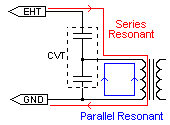|
At first it sounds ideal, using some of the power fed to the inputs to also provide power to the instrument or recording device. In theory it should work, but then practice was made to disprove theory.
Reason 2: This does not quite carry the same danger as the first although it is one that can be costly, as you'll have to go to site again to get proper readings. If you are fortunate enough not to have any resonance set up through the combination of L and C, you still have to adjust for the power taken by the instrument. Being an inductor the instrument will force a lag on the voltage throwing all phase related readings awry. The voltage will also be wrong as the instrument will become a formidable load on the output of the Capacitive VT. The load will also be highly non-linear meaning any harmonic readings are also non-worthy. This latter point is especially true of any instrument powered by a SMPS coupled to the CVT.
The only concerns are that the voltage output is sufficient to power the instrument. Mistakes have been known to be made where the voltage from the VTs is known as 110V 3-phase, but as this translates into only 63V phase to neutral it will most likely not power many instruments at all. Even modern SMPS units have a low cut off of around 85VAC. The reason for having a fair amount of drive capability is to ensure the non-linear load of the instrument's power supply does not affect the readings taken from this same source, especially harmonic content.
© 25.07.02 |
 MEASUREMENT TECHNIQUES:
MEASUREMENT TECHNIQUES: Reason 1: If the instrument is powered via a transformer, which can be viewed as mutually coupled inductors, then there is a possibility that resonance can occur. The primary winding can either parallel resonate with the lower capacitor forcing a very high voltage to appear, or series resonate with the upper capacitor forcing both a very high voltage and high current through the transformer and capacitor. The worry of resonance occurring is not limited only to the fundamental, but any harmonic as well.
Reason 1: If the instrument is powered via a transformer, which can be viewed as mutually coupled inductors, then there is a possibility that resonance can occur. The primary winding can either parallel resonate with the lower capacitor forcing a very high voltage to appear, or series resonate with the upper capacitor forcing both a very high voltage and high current through the transformer and capacitor. The worry of resonance occurring is not limited only to the fundamental, but any harmonic as well.